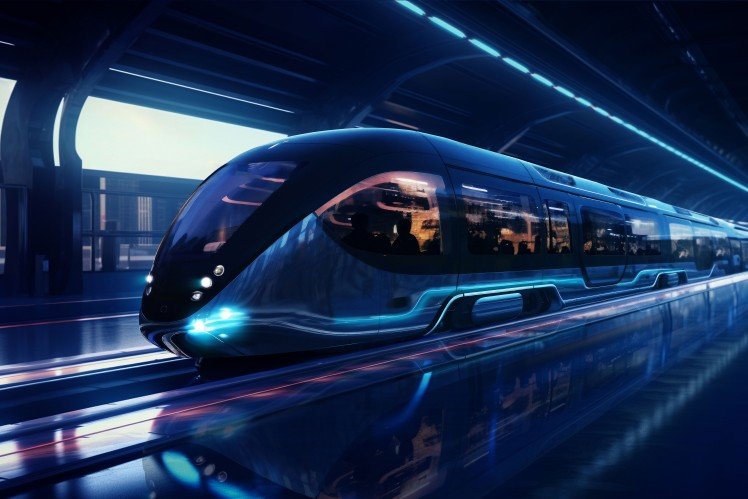A Century on Track: ZF Celebrates Anniversary in Railway Technology
Today, ZF railway technology is a trailblazer in the use of digital technologies for mobility applications.
www.zf.com

In the early summer of 2024, ZF will celebrate its 100th anniversary in the rail vehicle market: The first time ZF developed a drive system for railcars was in 1924. Back then, it was an adaptation of a technology that was primarily meant for passenger cars, the TS18.5 Soden transmission. In the decades that followed, the company further expanded its position as a supplier of railway technology. This was achieved through expansions and acquisitions, as well as through a strong international presence. Today, ZF boasts an impressive portfolio serving numerous rail vehicle manufacturers and operators worldwide. Additionally, the company stands out for its attractive digital offering. An exhibition at the ZF Forum in Friedrichshafen, beginning in June 2024, marks the anniversary. The Group will also bring attention to this tradition at the leading trade fair InnoTrans in September.
Comfort and efficiency have always been important, and this holds true for railway technology as well. With the advent of combustion railcars at the beginning of the 20th century, the aim was to maintain engines at the ideal operating point using a transmission. The shift points were designed to be so gentle that passengers and objects aboard wouldn’t be disturbed. The corresponding transmission technology came from ZF for the first time in 1924, as evidenced by a sketchbook entry. The company from Friedrichshafen, which had been established a mere nine years prior, adapted an invention of its then boss, the TS18.5 Soden transmission, so that it could be used in rail vehicles. The transmission was a forerunner of the automatic transmission systems that would come later. At that time, it already allowed the preselection of the next gear step and a correspondingly smooth gear change.
Recipe for Success: Innovation Capacity through Technology Transfer
This starting point represents the inception of a strength that ZF can still leverage today.
Markus Groß, product line manager for railway technology at ZF, explains:
“As a singular market, rail technology was not voluminous enough for the development of technological innovations in the field of transmission technology. ZF was able to capitalize on the transfer of its innovative driveline technology from other applications – especially commercial vehicles.”
Building on the blueprint from the early years, ZF later modified the Ecomat multi-ratio transmission to develop Ecomat Rail (predecessor of the current EcoLife Rail), and adapted the AS Tronic automated manual transmission to create AS Rail, specifically to meet the needs of diesel multiple units. However, ZF has also supplied mechanical drive components for electrified trains since the early days and continues to do so today for a wide range of rail vehicles. These include metros, trams, electric multiple units, high-speed trains, diesel multiple units, locomotives and special vehicles.
Rail technology, as an additional field of application for ZF technology, was of strategic importance for the Group. This was reflected in company takeovers throughout ZF’s history. In 1995, ZF incorporated Hurth Bahntechnik GmbH, a specialized supplier of rail transmissions, along with its production, logistics and service centers, into the Group. Shortly afterwards, the railway technology portfolio was expanded with rail dampers after the takeover of Mannesmann Sachs AG in 2001. As a result, the rail technology segment of the ZF Group grew into an overall supplier of driveline, chassis and safety technology for rail vehicles.
ZF products are now indispensable in rail vehicles around the globe. The rapid transit trains in almost all major cities around the world – from Istanbul to Shanghai to Lima – rely on ZF technology. ZF yaw dampers stabilize the swift and comfortable travel of high-speed trains operating in China or connecting mainland Europe with Great Britain via the Channel Tunnel.
Prof. Dr. Peter Laier, Member of the Board of Management of ZF, who is also responsible for Commercial Vehicle Solutions and Industrial Technology, underlines:
“Sustainable mobility of the future requires rail vehicles. With our 100-year commitment to rail technology and as a reliable partner and innovation supplier for manufacturers and operators of rail vehicles, we are living up to our strategic claim.”
Digital Services Complementing Hardware
With the connect@rail condition monitoring system, ZF has expanded its offering to include attractive digital services. It helps to make the operation and maintenance work more predictable and to avoid failures and downtimes. Also, connect@rail can monitor rail infrastructure to facilitate better planning for repairs.
In railway technology, maintenance and repair are important, as is repowering (i.e., equipping existing rail vehicles with new drive units). Here, ZF’s railway technology customers can benefit from the worldwide presence of the ZF Aftermarket Division, which provides fast spare parts, technical information and flexible service offerings.
Exhibition at the ZF Forum
With an exhibition at the ZF Forum, ZF is celebrating the Group’s 100th anniversary in railway technology. The exhibition showcases key contributions from ZF and the companies Hurth and Sachs, which are now part of the Group, over the past century.
www.zf.com

